Online shoppers expect personalization, but privacy concerns are changing the rules. What if you could tailor the eCommerce customer experience without explicit personal data? Enter 1:1 personalization: the new way to give every visitor what they want when they want it. Here’s everything you need to know.
Ever had that moment when an online shop just gets you, showing you exactly what you want? More likely, you’ve had the opposite: endless irrelevant results. The reality is most online stores still struggle with so-called “personalization.” It frustrates shoppers and costs businesses money. And as privacy concerns grow, the third-party data companies have relied on won’t be as accessible going forward. Smarter, privacy-friendly solutions are a must – not only to make shoppers happy but to drive sales and build long-term loyalty, too.
That’s where 1:1 personalization comes in, using real-time signals to tailor each customer’s experience from their first session on your site.
71% of consumers expect companies to deliver personalized interactions, and 76% get frustrated when it doesn’t happen.
Personalization key terms defined
The world of data and personalization is filled with buzzwords, but what do they all mean and which ones do eCommerce businesses need to know about?
- Micro-segmentation splits your customers into tiny groups based on demographics (e.g. age, income level, geography, etc.) and psychographics (favorite colors, brands, pets, etc.). This helps with targeting, but it lacks precision because it can’t always determine what the individuals in each segment like, often resulting in irrelevant suggestions and stereotyping.
- Personalization drills down to the individual level, wielding user attributes and historical data to tailor the shopping experience to each customer. Unlike 1:1 personalization, standard personalization doesn’t recognize contextual information, like the user’s immediate intent.
- 1:1 personalization (aka one to one personalization) takes standard personalization further by combining historical and real-time user data to customize the experience to the individual at that moment in time. It also recognizes when a shopper’s search intent switches mid-session, dynamically adapting to reflect what they’re looking for next.
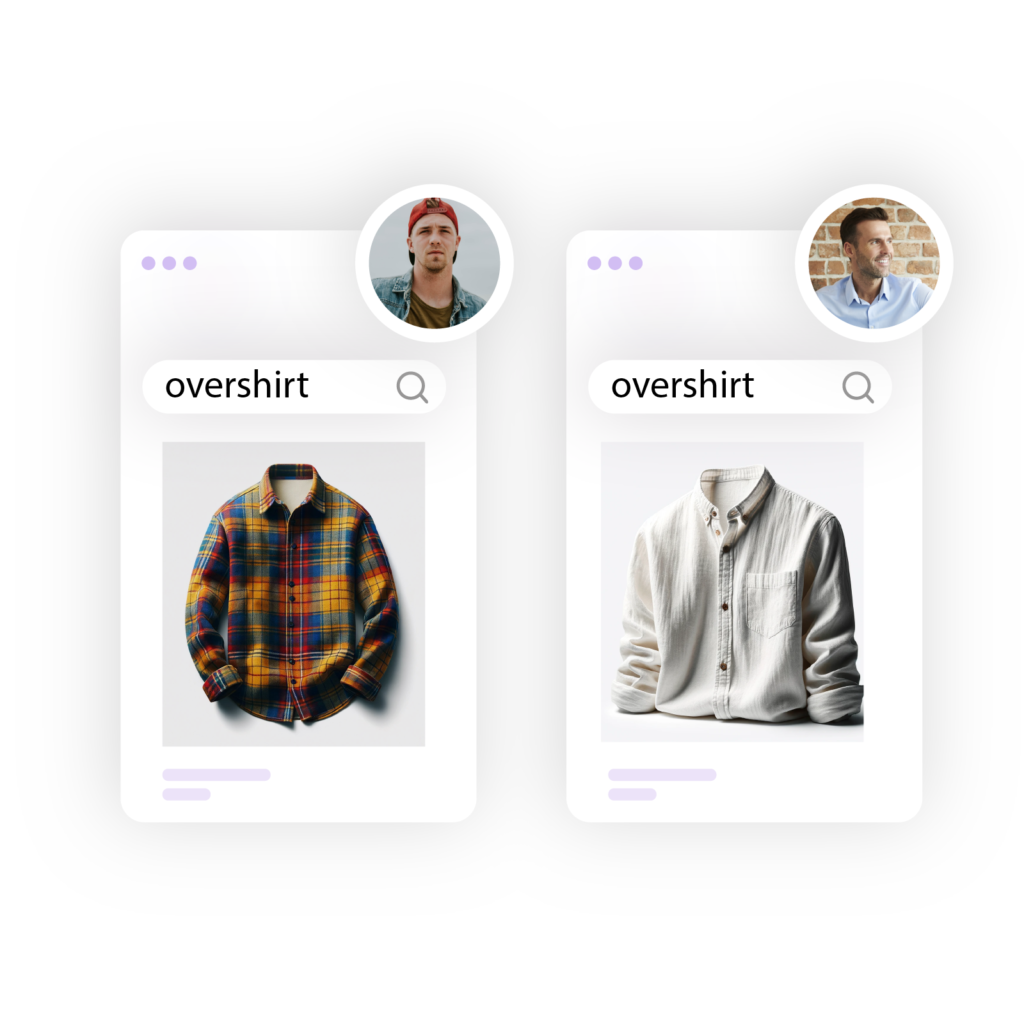
- First-party data is gathered directly from your website visitors. You can collect this explicitly through forms, live chats, etc. or implicitly by tracking their interactions on your site. FactFinder’s 1:1 personalization taps into this implicit data via Atlas AI, while drawing insights from their purchases. Because no other sources are involved, first-party data is generally more reliable and helps you stay in line with privacy regulations.
- Third-party data is bought or sourced from providers that aren’t connected to your company or audience. It has a much broader scope but can lead to inaccuracies since it rarely aligns with your actual customers. That’s why FactFinder doesn’t use third-party data: it gets in the way of delivering a truly 1:1 personalized customer experience. Plus, it’s often unclear where it’s from and whether it has been collected according to privacy regulations.
Converting first-time customers with 1:1 personalization
Imagine a new customer visits your online shop for the first time. Let’s call her Anna. Depending on her cookie settings, you might know her device, location and how she landed on your site, but little else. Your system learns more about her as she navigates your site, whether she’s applying filters, engaging with content or making a purchase.
Anna searches for “running leggings”. With no previous customer history to go on, your engine shows her a mix of running leggings across brands, sizes, colors, etc. She clicks on a pair, selects size and color, but doesn’t add them to her cart.
Anna then runs a search for “Gymshark”. Instead of general results, the engine registers her intent and ranks Gymshark running leggings first, in her preferred size and color.
This is 1:1 personalization at work. Even before Anna makes a purchase or shares any details explicitly, she benefits from search results tailored to both her preferences and immediate needs.
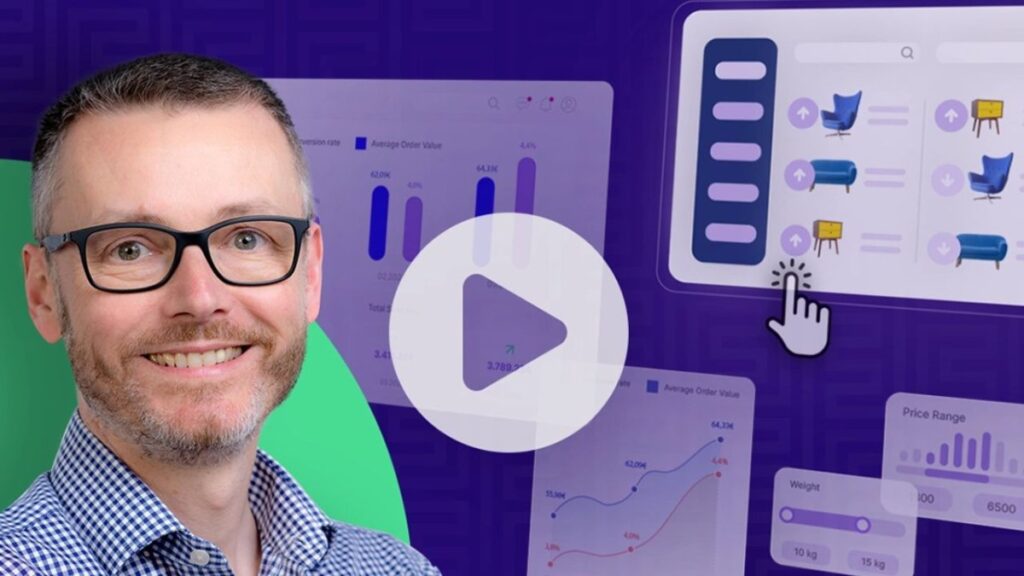
Want a more visual explanation?
Hit play on this dynamic demo experience to see how 1:1 personalization works for B2B and B2C stores.
Raising AOV with personalized recommendations
1:1 personalization can boost your average order value (AOV) by showing visitors ultra-relevant recommendations. Most online shops suggest products based on what other customers have bought. But with 1:1 personalization, recommendations evolve as the shopper moves through the site. They adapt to shifting intents to ensure shoppers always see the most relevant upsells and add-ons.
Let’s say Anna adds black Gymshark running leggings to her cart. At the check-out page, the AI recommends her running shoes and tank tops to complete the outfit. If she searched for gym leggings, the engine would recommend hybrid and indoor sneakers.
In this way, 1:1 personalization goes beyond helping customers find what they need, inspiring them to discover ideal add-ons they hadn’t thought to look for. It even considers new and niche items other engines typically ignore.
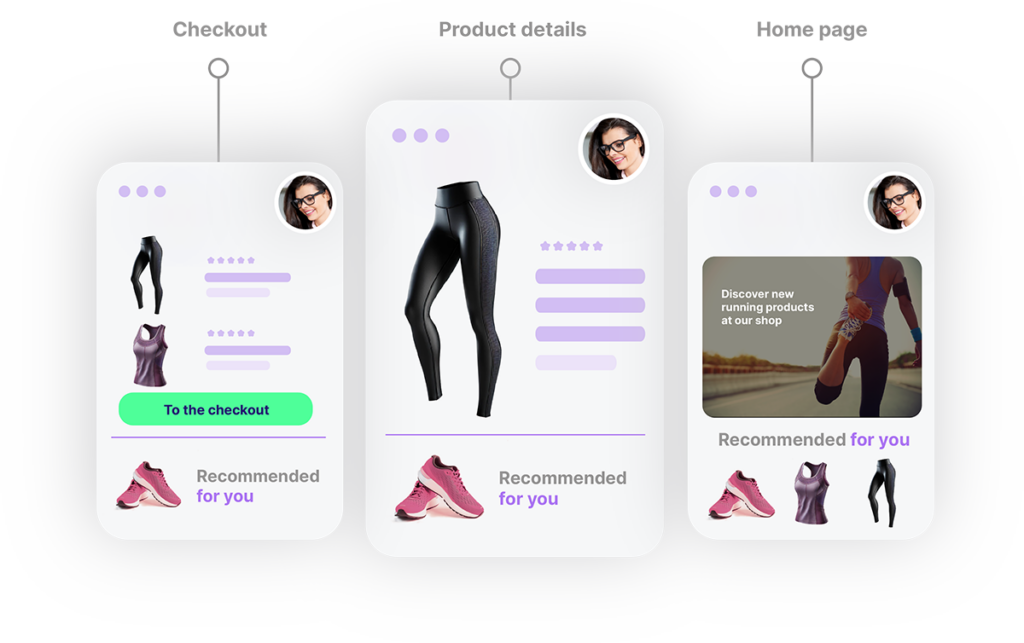
This works in a B2B context, too. Businesses looking for machinery, for example, will be recommended components compatible with the products they add to their cart. The AI processes complex product data at lightning speed, enabling it to suggest models that match customers’ specific requirements.
Zeppelin Baumaschinen GmbH, a B2B machinery and spare parts vendor, boosted search accuracy and tripled conversions after adopting FactFinder. Find out how they transformed their online shop.
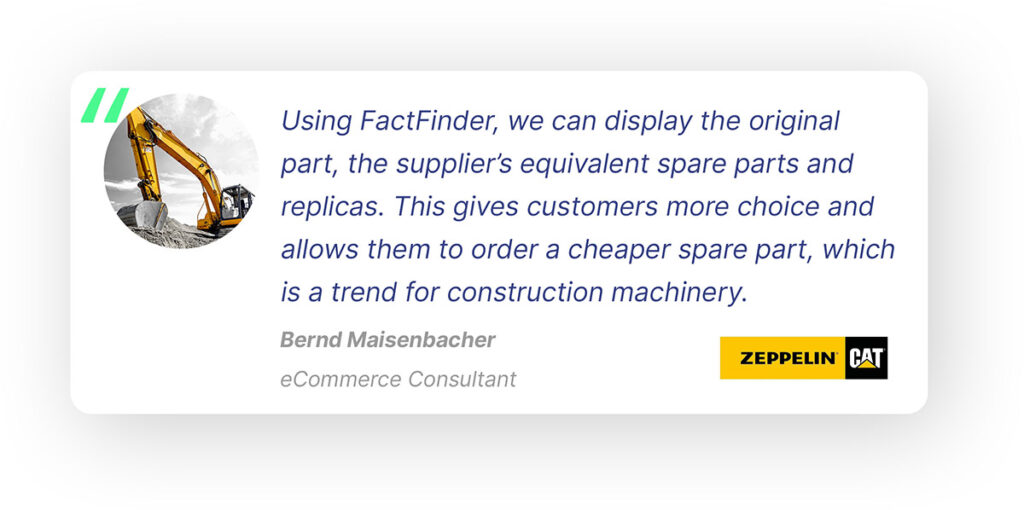
Turning first-time customers into lifelong fans
41% of an ecommerce store’s revenue is created by 8% of its customers, and your top 5% of customers generate 35% of revenue.
You’ve converted Anna from a first-time visitor into a paying customer and raised her AOV. But how do you win her long-term loyalty?
Having helped her find what she was looking for quickly and easily with 1:1 personalization, you’ve already done a lot of the work. According to McKinsey, 78% of consumers are more likely to make repeat purchases from companies that personalize and recommend them to friends and family.
However, a fantastic eCommerce customer experience isn’t always enough. Some people need reminders to choose your brand for new purchases – or to make that purchase in the first place.
With 1:1 personalization, you can embed AI-powered recommendations into emails, ads and texts, suggesting products that complement each contact’s purchases and browsing history.
You might even provide personalized pricing, offering exclusive discounts for returning customers and larger rewards for those who spend more. Personalized pricing really shines in a B2B context, where you can show negotiated rates, tiered models and VAT-inclusive or exclusive options.
How 1:1 personalization works for returning customers
A month later, Anna returns to your online shop. Your system has learned from her purchase history. But it also knows her intent has shifted. So instead of just showing leggings, it greets her with a fresh mix of items that match her preferences.
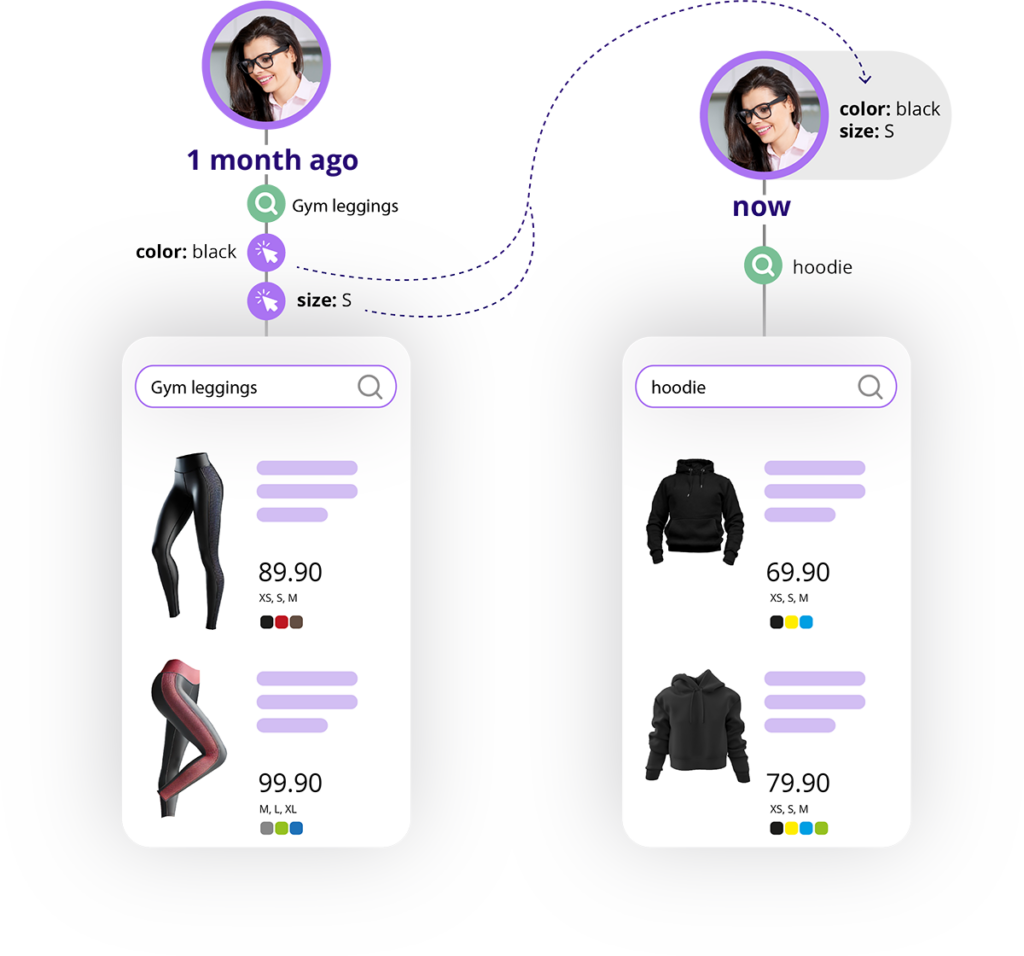
This time, Anna searches for a hoodie. With 1:1 personalization in place, your system shows hoodies in her size and preferred colors, with Gymshark at the top. It balances context with past purchases to help her find what she needs faster, preventing decision fatigue and making the eCommerce customer experience more intuitive.
Likewise, a returning B2B customer will see products aligning with their purchase history, such as screen protectors and hard drives that fit their company laptops.
Adapting to customers’ contradictive nature
1:1 personalization stands out for its ability to recognize each customer’s contradictions and complexities.
Anna might prefer Gymshark leggings but Superdry hoodies and simply buy the cheapest socks available, regardless of brand. Standard personalization techniques often struggle to address these nuances, leading to missed opportunities.
FactFinder’s 1:1 personalization, on the other hand, applies customers’ preferences in different levels of detail, automatically adjusting to individuals’ eclectic tastes. This saves you development time and effort while improving the relevance of search results and recommendations.
Shortly after switching to FactFinder’s AI-driven personalization solution, Tabakguru increased its repeat buyer rate to 60%. See the full impact it had on their business.
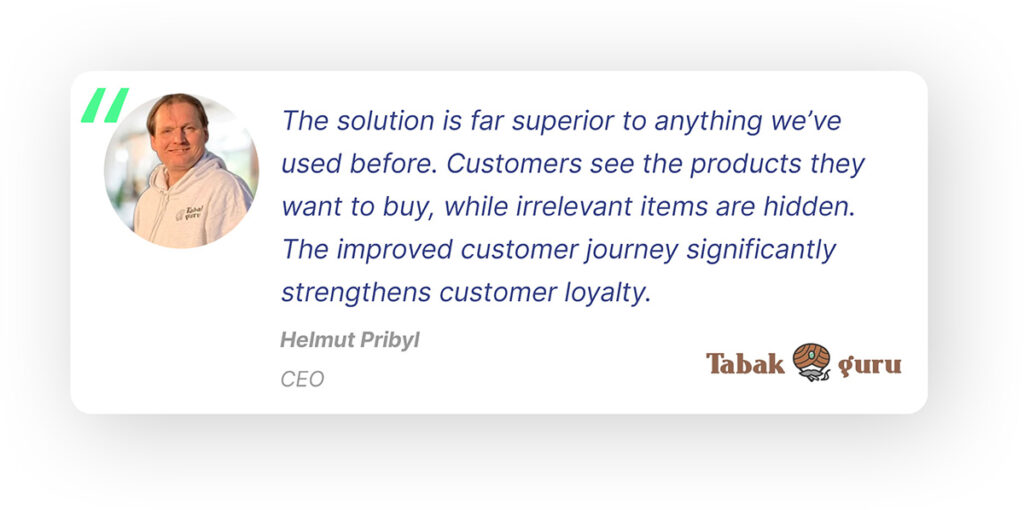
The future of personalization in eCommerce, featuring insights from Forrester
Tools like DALL-E 2 and ChatGPT have impressively shown us what is already possible with AI. Especially for eCommerce, there are exciting opportunities around AI and personalization. That’s why we sat down with Brendan Witcher, VP & Principal Analyst at Forrester, to explore the current state of the market, best practices for personalization, and insights into what the future holds. Check out the video below.
1:1 personalization in search and product discovery
While personalization has helped increase some business’ revenue, it can’t operate alone. After all, how can your online store personalize the shopping journey if it doesn’t recognize the search term?
An exceptional eCommerce customer experience starts with sophisticated search and product discovery. One that’s smart enough to handle misspellings, synonyms, even intent-based queries and still get it right, every time.
Kübler Sport, a leading B2B and B2C sports and fitness retailer, switched to FactFinder when their site search solution couldn’t find what shoppers wanted. Since then, the retailer has seen a 35% increase in conversions and an influx of positive feedback. Now, they’re ready to take the customer experience further by integrating 1:1 personalization technology. Discover the secret to their success.
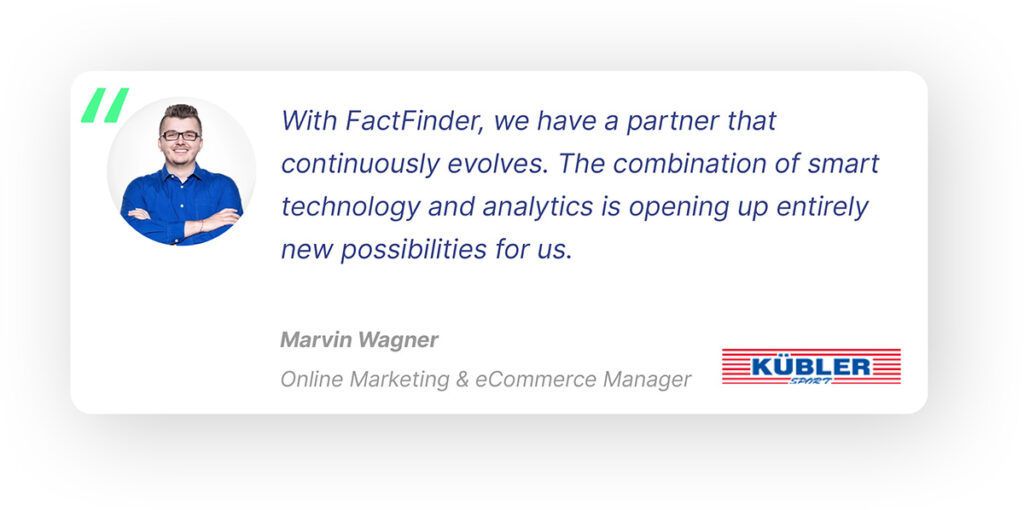
How to achieve 1:1 personalization
A search and product discovery platform using 1:1 personalization should continuously self-optimize to keep up with customers’ changing needs and how they relate to your product range. This is only possible (and scalable) with AI.
Every online shopper searches differently. Two people may use the same search query but mean wildly varying things. Atlas AI gets around this by tracking how customers behave outside the search, including the categories, products and filters they click on. Your store can then adapt in real time to provide each customer with personalized, contextually relevant suggestions. No need for explicit first- or third-party data.
Beyond this, our 1:1 personalization uses wisdom of the crowd to self-optimize for general relevance, building a deep understanding of the relationship between your products and how they relate to different search queries and interactions.
Unlike other AI models, FactFinder needs minimal learning data, enabling it to scale up fast and deliver true 1:1 personalization from the get-go. Automation covers everything that would never be possible with manual segmentation rules. That said, you have the option to manually adjust ranking rules to your liking. For example, you can pin products from the latest merchandising campaigns at the top of the results and downrank out of stock items. You might also choose to manually select cross- and up-sell products to match your sales strategy. It’s the perfect balance of automation and (optional) control.
Future-proof your business with 1:1 personalization
As consumers grow frustrated with eCommerce customer experiences based on standard segmentation and personalization techniques, 1:1 personalization can set your brand apart. Using minimal data, this AI-powered technology delivers tailored results and recommendations using real-time signals. It not only saves shoppers from sharing their personal details but also picks up on their immediate search intent to show them exactly what they want at that moment in time.
Shoppers want intuitive, helpful interactions, not brands that feel like they’re watching their every move. FactFinder’s solution delivers just that, boosting conversions, AOV and customer loyalty with no need for sensitive information.

FAQs
What’s the difference between 1:1 personalization and standard personalization?
Standard personalization doesn’t recognize contextual information like the user’s immediate intent. 1:1 personalization (also known as one to one personalization) combines historical and real-time customer data to tailor the experience not only to the individual but to that individual at that moment in time.
What are the benefits of 1:1 personalization?
1:1 personalization has many advantages for eCommerce businesses:
- You avoid coming across as overly personal – 1:1 personalization’s focus on search intent data means you don’t need to follow shoppers across apps and social media to provide ultra-relevant search results and recommendations.
- Prevents clumsy segmentation-based targeting – you no longer have to rely on segmentation techniques based on demographics, which can’t accurately determine a customer’s interests or search intent.
- No need for sensitive data – eliminating the need for customers to share their information for a personalized experience.
- Saves labor time and resources – AI-powered 1:1 personalization saves your team valuable time, avoiding the need to manually create and update rules based on segments.
- Personalized experience for first-time customers – helping new shoppers quickly find what they’re looking for and check out without choice overload or irrelevant suggestions.
What data is required for 1:1 personalization?
It depends on the solution you use. FactFinder’s 1:1 personalization uses real-time search intent and behavior. It learns with every interaction, from running a search to interacting with a product, selecting a certain category, adjusting the filters and more. No personal data is required, so even first-time visitors get a tailored experience. However, if customers willingly share details like their location with you, you can use this to enhance their experience with localized search results and recommendations.
How many visits does it take for 1:1 personalization to work?
None. No prior personal data is required, so shoppers get a personalized experience from their very first visit. And after their first purchase, the AI combines their customer history with their real-time behavior every time they come back to your shop, strengthening its understanding with each interaction.
Can you set up 1:1 personalization manually?
Not really. You’d have to create rules for every segment using traditional or micro-segmentation, which takes a lot of time and effort. It doesn’t scale well, so unless your customer base is tiny, delivering a truly one-to-one experience (especially in real time) is impossible.
How long does it take to implement 1:1 personalization technology?
Every system is different, but if you’re already using FactFinder’s search and product discovery solution, it only takes 1 to 3 days on average. If you’re interested in adding 1:1 personalization, get in touch here or contact your customer success manager.
How much does 1:1 personalization technology cost?
The cost varies depending on the solution you use. If you’re interested in FactFinder’s advanced 1:1 personalization, get in touch for a free demo and a quote.